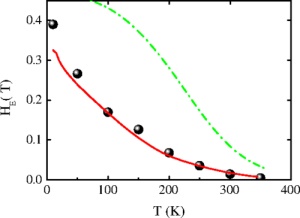|
xxxx
|
 XXXXXXXXXXXXXXXXXXXXXXXXXXXXXXXXXXXXXXXXXXXXXXXXXXXXXXXXXXXX XXXXXXXXXXXXXXXXXXXXXXXXXXXXXXXXXXXXXXXXXXXXXXXXXXXXXXXXXXXX
High Temperature Magnetic Stabilization of Cobalt Nanoparticles by an Antiferromagnetic Proximity Effect
BaC6
Valquiria Fernanda Lima
Tuesday, April 12, 2016
Thermal activation tends to destroy the magnetic stability of small magnetic nanoparticles, with crucial implications for ultrahigh density recording among other applications. Here we demonstrate that low-blocking-temperature ferromagnetic (FM) Co nanoparticles (TB<70 K) become magnetically stable above 400 K when embedded in a high-Néel-temperature antiferromagnetic (AFM) NiO matrix. The origin of this remarkable TBenhancement is due to a magnetic proximity effect between a thin CoO shell (with low Néel temperature, TN, and high anisotropy, KAFM) surrounding the Co nanoparticles and the NiO matrix (with high TNbut low KAFM). This proximity effect yields an effective antiferromagnet with an apparent TNbeyond that of bulk CoO, and an enhanced anisotropy compared to NiO. In turn, the Co core FM moment is stabilized against thermal fluctuations via core-shell exchange-bias coupling, leading to the observed TBincrease. Mean-field calculations provide a semiquantitative understanding of this magnetic-proximity stabilization mechanism.
View full text
|